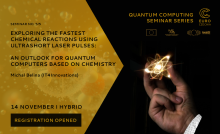Course/Event Essentials
Training Content and Scope
Other Information
Annotation
The development of laser technologies has opened the way for femtochemistry—the study of chemical reactions (rearrangement of molecular or ionic structures) using femtosecond laser pulses. Although the Nobel Prize for this work was awarded in 1999, it took another 20 years to squeeze pulse widths sufficiently to capture the fastest processes.
In this talk, I will describe the revelation of the reaction rates associated with the fastest chemical reaction known so far: the transfer of hydrogen nuclei, H⁺. Despite its unfamiliar description, this process is involved in most acidic reactions. Remarkably, the chemical rate is approximately 50 fs, regardless of the molecule studied, the system size, or the initial trigger. Complementary theoretical and experimental perspectives will be covered.
Suitable for studying such reactions, laser pulses with photon energies ranging from UV to X-rays will serve as a springboard to discussing quantum computer architectures based on chemical principles. A critical review of possible architectures will be provided.



